Bio-Herbicidal Potential of Nanoemulsions with Peppermint Oil on Barnyard Grass and Maize
Abstract
:1. Introduction
2. Results
2.1. Chemical Composition of Peppermint Essential Oil Used in the Study
2.2. The Influence of Input Parameters on Properties of Obtained Nanoemulsions
2.3. Metabolic Activity of Maize and Barnyardgrass Seedlings Treated with PNs
2.4. FT-Raman Spectroscopy of Maize and Barnyardgrass Seedlings Treated with PNs
2.5. Herbicidal Effects of Leaf-Sprayed PNs on Maize and Barnyard Grass
3. Discussion
4. Materials and Methods
4.1. Chemical Composition of Peppermint Essential oil Used in the Study
4.2. Nanoemulsion (PN) Preparation and Physicochemical Characteristics
- -
- essential oil concentration (%): 1, 3, 5;
- -
- emulsifier concentration (%): 1, 3, 5;
- -
- amplitude (%): 69, 79, 89
- -
- sonification time (min.): 1, 2, 3.
4.3. Metabolic Activity of Maize and Barnyardgrass Seedlings Treated with PNs
4.4. FT-Raman Spectroscopy of Maize and Barnyardgrass Seedlings Treated with PNs
4.5. Herbicidal Effects of Leaf-Sprayed PNs on Maize and Barnyard Grass
- Control pots (C), plants sprayed with distilled water only;
- Herbicide control (H), plants sprayed with a commercial mixture of herbicide foramsulfuron + iodosulfuron-methyl sodium + thiencarbazone methyl (39.4 + 1.25 + 12.5 g ha−1; MaisTER Power 42.5 OD, Bayer CropSci, PL);
- Two surfactant-only sprays at the dose of surfactant: 1% (S1) and 10% (S5);
- Five doses of PNs: 1% (PN1), 1.5% (PN2); 2% (PN3); 5% (PN4), and 10% (PN5).
4.5.1. Chlorophyll a Fluorescence Measurements
4.5.2. Relative Water Content (RWC)
4.5.3. Statistical Analyses
Supplementary Materials
Author Contributions
Funding
Institutional Review Board Statement
Informed Consent Statement
Data Availability Statement
Conflicts of Interest
Sample Availability
References
- Prasad, R.; Bhattacharyya, A.; Nguyen, Q.D. Nanotechnology in Sustainable Agriculture: Recent Developments, Challenges, and Perspectives. Front. Microbiol. 2017, 8, 1014. [Google Scholar] [CrossRef] [PubMed] [Green Version]
- Shang, Y.; Hasan, M.K.; Ahammed, G.J.; Li, M.; Yin, H.; Zhou, J. Applications of Nanotechnology in Plant Growth and Crop Protection: A review. Molecules 2019, 24, 2558. [Google Scholar] [CrossRef] [PubMed] [Green Version]
- Isman, M.B. Botanical insecticides in the twenty-first century—Fulfilling their promise? Ann. Rev. Entomol. 2020, 65, 233–249. [Google Scholar] [CrossRef] [PubMed] [Green Version]
- Verdeguer, M.; Sánchez-Moreiras, A.M.; Araniti, F. Phytotoxic Effects and Mechanism of Action of Essential Oils and Terpenoids. Plants 2020, 9, 1571. [Google Scholar] [CrossRef] [PubMed]
- Grul’ová, D.; Pl’uchtová, M.; Fejér, J.; De Martino, L.; Caputo, L.; Sedlák, V.; De Feo, V. Influence of six essential oils on invasive Solidago canadensis L. seed germination. Nat. Prod. Res. 2020, 34, 3231–3233. [Google Scholar] [CrossRef]
- Synowiec, A.; Kalemba, D.; Drozdek, E.; Bocianowski, J. Phytotoxic potential of essential oils from temperate climate plants against the germination of selected weeds and crops. J. Pest Sci. 2017, 90, 407–419. [Google Scholar] [CrossRef]
- Pisulewska, E.; Fijolek, M.; Witkowicz, R. The share of peppermint (Mentha piperita L.) in the cropping structure and its cultivation technology in the Michalow commune. Zesz. Probl. Postępów Nauk. Rol. 2010, 549, 149–156. (In Polish) [Google Scholar]
- The European Pharmacopoeia, 6th ed.; Ph.Eur.6.0; Council of Europe: Strasbourg, France, 2007.
- Kalemba, D.; Synowiec, A. Agrobiological interactions of essential oils of two menthol mints: Mentha piperita and Mentha arvensis. Molecules 2019, 25, 59. [Google Scholar] [CrossRef] [Green Version]
- Synowiec, A.; Możdżeń, K.; Skoczowski, A. Early physiological response of broccoli leaf to foliar application of clove oil and its main constituents. Ind. Crops Prod. 2015, 74, 523–529. [Google Scholar] [CrossRef]
- Taban, A.; Saharkhiz, M.J.; Khorram, M. Formulation and assessment of nano-encapsulated bioherbicides based on biopolymers and essential oil. Ind. Crops Prod. 2020, 149, 112348. [Google Scholar] [CrossRef]
- Turek, C.; Stintzing, F.C. Stability of essential oils: A review. Compr. Rev. Food Sci. Food Saf. 2013, 12, 40–53. [Google Scholar] [CrossRef]
- Billa, A.R.; Guccione, C.; Isacchi, B.; Righeschi, C.; Firenzuoli, F.; Bergonzi, M.C. Essential oils loaded in nanosystems: A developing strategy for a successful therapeutic approach. Evid. Complement Altern. Med. 2014, 2014, 651593. [Google Scholar] [CrossRef] [PubMed] [Green Version]
- Kaur, P.; Gupta, S.; Kaur, K.; Kaur, N.; Kumar, R.; Bhullar, M.S. Nanoemulsion of Foeniculum vulgare essential oil: A propitious striver against weeds of Triticum aestivum. Ind. Crops Prod. 2021, 168, 113601. [Google Scholar] [CrossRef]
- Yadav, A.S.; Srivastava, D.S. Application of nanotechnology in weed management: A review. J. Crop Sci. Technol. 2015, 4, 21–23. [Google Scholar] [CrossRef]
- Miastkowska, M.; Michalczyk, A.; Figacz, K.; Sikora, E. Nanoformulations as a modern form of biofungicide. J. Environ. Health Sci. Eng. 2020, 18, 119–128. [Google Scholar] [CrossRef] [PubMed] [Green Version]
- Heydari, M.; Amirjani, A.; Bagheri, M.; Sharifian, I.; Sabahi, Q. Eco-friendly pesticide based on peppermint oil nanoemulsion: Preparation, physicochemical properties, and its aphicidal activity against cotton aphid. Environ. Sci. Pollut. Res. 2020, 27, 6667–6679. [Google Scholar] [CrossRef] [PubMed]
- Massoud, M.A.; Adel, M.M.; Zaghloul, O.A.; Mohamed, M.I.; Abdel-Rheim, K.H. Eco-Friendly Nano-emulsion Formulation of Mentha piperita Against Stored Product pest Sitophilus oryzae. Adv. Crop Sci. Technol. 2018, 6, 1–6. [Google Scholar] [CrossRef]
- Liang, R.; Xu, S.; Shoemaker, C.F.; Li, Y.; Zhong, F.; Huang, Q. Physical and antimicrobial properties of peppermint oil nanoemulsions. J. Agric. Food Chem. 2012, 60, 7548–7555. [Google Scholar] [CrossRef]
- Barzegar, H.; Mehrnia, M.A.; Nasehi, B.; Alipour, M. Fabrication of peppermint essential oil nanoemulsions by spontaneous method: Effect of preparing conditions on droplet size. Flavour Fragr. J. 2018, 33, 351–356. [Google Scholar] [CrossRef]
- Synowiec, A.; Halecki, W.; Wielgusz, K.; Byczyńska, M.; Czaplicki, S. Effect of fatty acid methyl esters on the herbicidal effect of essential oils on corn and weeds. Weed Technol. 2017, 31, 301–309. [Google Scholar] [CrossRef]
- Synowiec, A.; Możdżeń, K.; Krajewska, A.; Landi, M.; Araniti, F. Carum carvi L. essential oil: A promising candidate for botanical herbicide against Echinochloa crus-galli (L.) P. Beauv. in maize cultivation. Ind. Crops Prod. 2019, 140, 111652. [Google Scholar] [CrossRef]
- Hayes, D.G.; Smith, G.A. Biobased Surfactants: Overview and Industrial State of the Art. In Biobased Surfactants, 2nd ed.; Hayes, D.G., Solaiman, D.K.Y., Ashby, R.D., Eds.; AOCS Press: London, UK, 2019; pp. 3–38. [Google Scholar] [CrossRef]
- Ismail, N.L.; Shahruddin, S.; Othman, J. Overview of Bio-Based Surfactant: Recent Development, Industrial Challenge, and Future Outlook. In Surfactants; Dutta, A.K., Ed.; IntechOpen: London, UK, 2022. [Google Scholar] [CrossRef]
- European Pharmacopoeia, 7th ed.; Council of Europe: Strasburg, France, 2010.
- Kizil, R.; Irudayaraj, J.; Seetharaman, K. Characterization of irradiated starches by using FT-Raman and FTIR spectroscopy. J. Agric. Food Chem. 2002, 50, 3912–3918. [Google Scholar] [CrossRef] [PubMed]
- Almeida, M.R.; Alves, R.S.; Nascimbem, L.B.; Stephani, R.; Poppi, R.J.; de Oliveira, L.F. Determination of amylose content in starch using Raman spectroscopy and multivariate calibration analysis. Anal. Bioanal. Chem. 2010, 397, 2693–2701. [Google Scholar] [CrossRef] [PubMed]
- Edwards, H.G.; Farwell, D.W.; Webster, D. FT Raman microscopy of untreated natural plant fibres. Spectrochim. Acta A 1997, 53, 2383–2392. [Google Scholar] [CrossRef]
- Yu, M.M.; Schulze, H.G.; Jetter, R.; Blades, M.W.; Turner, R.F. Raman microspectroscopic analysis of triterpenoids found in plant cuticles. Appl. Spectrosc. 2007, 61, 32–37. [Google Scholar] [CrossRef]
- Kang, L.; Wang, K.; Li, X.; Zou, B. High Pressure Structural Investigation of Benzoic Acid: Raman Spectroscopy and X-ray Diffraction. J. Phys. Chem. C 2016, 120, 14758–14766. [Google Scholar] [CrossRef]
- Li-Chan, E.C.Y. The applications of Raman spectroscopy in food science. Trends Food Sci. Technol. 1996, 7, 361–370. [Google Scholar] [CrossRef]
- Donsì, F.; Annunziata, M.; Sessa, M.; Ferrari, G. Nanoencapsulation of essential oils to enhance their antimicrobial activity in foods. LWT-Food Sci. Technol. 2011, 44, 1908–1914. [Google Scholar] [CrossRef]
- Anjali, C.H.; Sharma, Y.; Mukherjee, A.; Chandrasekaran, N. Neem oil (Azadirachta indica) nanoemulsion—A potent larvicidal agent against Culex quinquefasciatus. Pest Manag. Sci. 2012, 68, 158–163. [Google Scholar] [CrossRef]
- Kaur, H.; Bhardwaj, U.; Kaur, R. Cymbopogon nardus essential oil: A comprehensive review on its chemistry and bioactivity. J. Essent. Oil Res. 2021, 33, 205–220. [Google Scholar] [CrossRef]
- Hazrati, H.; Saharkhiz, M.J.; Niakousari, M.; Moein, M. Natural herbicide activity of Satureja hortensis L. essential oil nanoemulsion on the seed germination and morphophysiological features of two important weed species. Ecotoxicol. Environ. Saf. 2017, 142, 423–430. [Google Scholar] [CrossRef]
- Edris, A.; Rawlinson-Malone, C. Alcohol-Free Delivery System Carrying Thyme Essential Oil Nanoparticles Formulated via Microemulsion Technique. Adv. Sci. Eng. Med. 2011, 3, 219–225. [Google Scholar] [CrossRef]
- Rehman, A.; Jafari, S.M.; Tong, Q.; Karim, A.; Mahdi, A.A.; Iqbal, M.W.; Aadil, R.M.; Ali, A.; Manzoor, M.F. Role of peppermint oil in improving the oxidative stability and antioxidant capacity of borage seed oil-loaded nanoemulsions fabricated by modified starch. Int. J. Biol. Macromol. 2020, 153, 697–707. [Google Scholar] [CrossRef] [PubMed]
- Stokłosa, A.; Janeczko, A.; Skoczowski, A.; Kieć, J. Isothermal calorimetry as a tool for estimating resistance of wild oat (Avena fatua L.) to aryloxyphenoxypropionate herbicides. Thermochim. Acta 2006, 441, 203–206. [Google Scholar] [CrossRef]
- Troć, M.; Skoczowski, A.; Barańska, M. The influence of sunflower and mustard leaf extracts on the germination of mustard seeds. J. Therm. Anal. Calorim. 2009, 95, 727–730. [Google Scholar] [CrossRef]
- Saja, D.; Rys, M.; Stokłosa, A.; Skoczowski, A. Physiological tests for early detection of rigid ryegrass (Lolium rigidum goud.) resistance to fenoxaprop-p. Acta Physiol. Plant. 2014, 36, 485–491. [Google Scholar] [CrossRef] [Green Version]
- Kupidłowska, E.; Gniazdowska, A.; Stępień, J.; Corbineau, F.; Vinel, D.; Skoczowski, A.; Janeczko, A.; Bogatek, R. Impact of sunflower (Helianthus annuus L.) extracts upon reserve mobilization and energy metabolism in germinating mustard (Sinapis alba L.) seeds. J. Chem. Ecol. 2006, 32, 2569–2583. [Google Scholar] [CrossRef]
- Schabes, F.I.; Sigstad, E.E. A calorimetric study of the allelopathic effect of cnicin isolated from Centaurea diffusa Lam. on the germination of soybean (Glycine max) and radish (Raphanus sativus). Thermochim. Acta 2007, 458, 84–87. [Google Scholar] [CrossRef]
- Skoczowski, A.; Troć, M.; Baran, A.; Baranska, M. Impact of sunflower and mustard leave extracts on the growth and dark respiration of mustard seedlings. J. Therm. Anal. Calorim. 2011, 104, 187–192. [Google Scholar] [CrossRef]
- Troć, M.; Saja, D.; Kornas, A.; Żuraw, A.; Skoczowski, A. Strong endothermic effects caused by allelopathic interactions during growth of mustard, rape, wheat and clover seedlings. J. Therm. Anal. Calorim. 2011, 104, 141–148. [Google Scholar] [CrossRef]
- Skoczowski, A.; Troć, M. Isothermal calorimetry and Raman spectroscopy to study response of plants to abiotic and biotic stress. In Molecular Stress Physiology of Plants; Rout, G.R., Das, A.B., Eds.; Springer: New Delhi, India, 2013; pp. 263–288. [Google Scholar]
- Edelstein, M.; Bradford, K.J.; Burger, D.W. Metabolic heat and CO2 production rates during germination of melon (Cucumis melo L.) seeds measured by microcalorimetry. Seed Sci. Res. 2001, 11, 265–272. [Google Scholar]
- Rys, M.; Saja-Garbarz, D.; Skoczowski, A. Phytotoxic Effects of Selected Herbal Extracts on the Germination, Growth and Metabolism of Mustard and Oilseed Rape. Agronomy 2022, 12, 110. [Google Scholar] [CrossRef]
- Rys, M.; Pociecha, E.; Oliwa, J.; Ostrowska, A.; Jurczyk, B.; Saja, D.; Janeczko, A. Deacclimation of Winter Oilseed Rape—Insight into Physiological Changes. Agronomy 2020, 10, 1565. [Google Scholar] [CrossRef]
- Skoczowski, A.; Oliwa, J.; Stawoska, I.; Rys, M.; Kocurek, M.; Czyczyło-Mysza, I. The Spectral Compositions of Light Changes Physiological Response of Chinese Cabbage to Elevated Ozone Concentration. Int. J. Mol. Sci. 2022, 23, 2941. [Google Scholar] [CrossRef]
- Rys, M.; Juhász, C.; Surówka, E.; Janeczko, A.; Saja, D.; Tóbiás, I.; Skoczowski, A.; Barna, B.; Gullner, G. Comparison of a compatible and an incompatible pepper-tobamovirus interaction by biochemical and non-invasive techniques: Chlorophyll a fluorescence, isothermal calorimetry and FT-Raman spectroscopy. Plant Physiol. Biochem. 2014, 83, 267–278. [Google Scholar] [CrossRef] [Green Version]
- Lukaszuk, E.; Rys, M.; Możdżeń, K.; Stawoska, I.; Skoczowski, A.; Ciereszko, I. Photosynthesis and sucrose metabolism in leaves of Arabidopsis thaliana aos, ein4 and rcd1 mutants as affected by wounding. Acta Physiol. Plant. 2017, 39, 17–28. [Google Scholar] [CrossRef] [Green Version]
- Surówka, E.; Latowski, D.; Dziurka, M.; Rys, M.; Maksymowicz, A.; Żur, I.; Olchawa-Pajor, M.; Desel, C.; Krzewska, M.; Miszalski, Z. ROS-Scavengers, Osmoprotectants and Violaxanthin De-Epoxidation in Salt-Stressed Arabidopsis thaliana with Different Tocopherol Composition. Int. J. Mol. Sci. 2021, 22, 11370. [Google Scholar] [CrossRef]
- Baranski, R.; Baranska, M.; Schulz, H. Changes in carotenoid content and distribution in living plant tissue can be observed and mapped in situ using NIR-FT-Raman spectroscopy. Planta 2005, 222, 448–457. [Google Scholar] [CrossRef]
- Synowiec, A.; Rys, M.; Bocianowski, J.; Wielgusz, K.; Byczyńska, M.; Heller, K.; Kalemba, D. Phytotoxic effect of fiber hemp essential oil on germination of some weeds and crops. J. Essent. Oil Bear. Plants 2016, 19, 262–276. [Google Scholar]
- Carter, T.E., Jr.; Patterson, R.P. Use of relative water content as a selection tool for drought tolerance in soybean. In Proceedings of the Fide Agron Abstr 77th Annual Meeting; Crop Science Society of America: Madison, WI, USA, 1985; p. 77. [Google Scholar]
- Lugojan, C.; Ciulca, S. Evaluation of relative water content in winter wheat. J. Hortic. For. Biotechnol. 2011, 15, 173–177. [Google Scholar]
- Kalaji, M.H.; Jajoo, A.; Oukarroum, A.; Brestic, M.; Zivcak, M.; Samborska, I.A.; Cetner, M.D.; Łukasik, I.; Goltsev, V.; Ladle, R.J.; et al. The use of chlorophyll fluorescence kinetics analysis to study the performance of photosynthetic machinery in plants. In Emerging Technologies and Management of Crop Stress Tolerance; Academic Press: Cambridge, MA, USA, 2014; Volume 2, pp. 347–384. [Google Scholar]
- Kalaji, M.H.; Jajoo, A.; Oukarroum, A.; Brestic, M.; Zivcak, M.; Samborska, I.A.; Cetner, M.D.; Łukasik, I.; Goltsev, V.; Ladle, R.J. Chlorophyll a fluorescence as a tool to monitor physiological status of plants under abiotic stress conditions. Acta Physiol. Plant. 2016, 38, 102. [Google Scholar] [CrossRef] [Green Version]
- Appenroth, K.J.; Stockel, J.; Srivastava, A.; Strasser, R.J. Multiple effects of chromate on the photosynthetic apparatus of Spirodela polyrhiza as probed by OJIP chlorophyll a fluorescence measurements. Environ. Pollut. 2001, 115, 49–64. [Google Scholar] [CrossRef]
- Adams, R.P. Identification of Essential Oil Components by Gas Chromatography/Mass Spectrometry; Allured Publishing Corporation: Carol Stream, IL, USA, 2007; Volume 456, pp. 544–545. [Google Scholar]
- Skoczowski, A.; Janeczko, A.; Gullner, G.; Tóbias, I.; Kornas, A.; Barna, B. Response of brassinosteroid-treated oilseed rape cotyledons to infection with the wild type and HR-mutant of Pseudomonas syringae or with P. fluorescence. J. Therm. Anal. Calorim. 2011, 104, 131–139. [Google Scholar] [CrossRef]
- Strasser, R.J.; Srivastava, A.; Tsimilli-Michael, M. The fluorescence transient as a tool to characterize and screen photosynthetic samples. In Probing Photosynthesis: Mechanism, Regulation and Adaptation; Yunus, M., Pathre, U., Mohanty, P., Eds.; Taylor and Francis: London, UK, 2000; pp. 443–480. [Google Scholar]
- Janowiak, F.; Markowski, A. Changes in leaf water relations and injuries in maize seedlings induced by different chilling conditions. J. Agron. Crop Sci. 1994, 172, 19–28. [Google Scholar] [CrossRef]
- Knezevic, S.Z.; Streibig, J.C.; Ritz, C. Utilizing R software package for dose-response studies: The concept and data analysis. Weed Technol. 2007, 21, 840–848. [Google Scholar] [CrossRef]
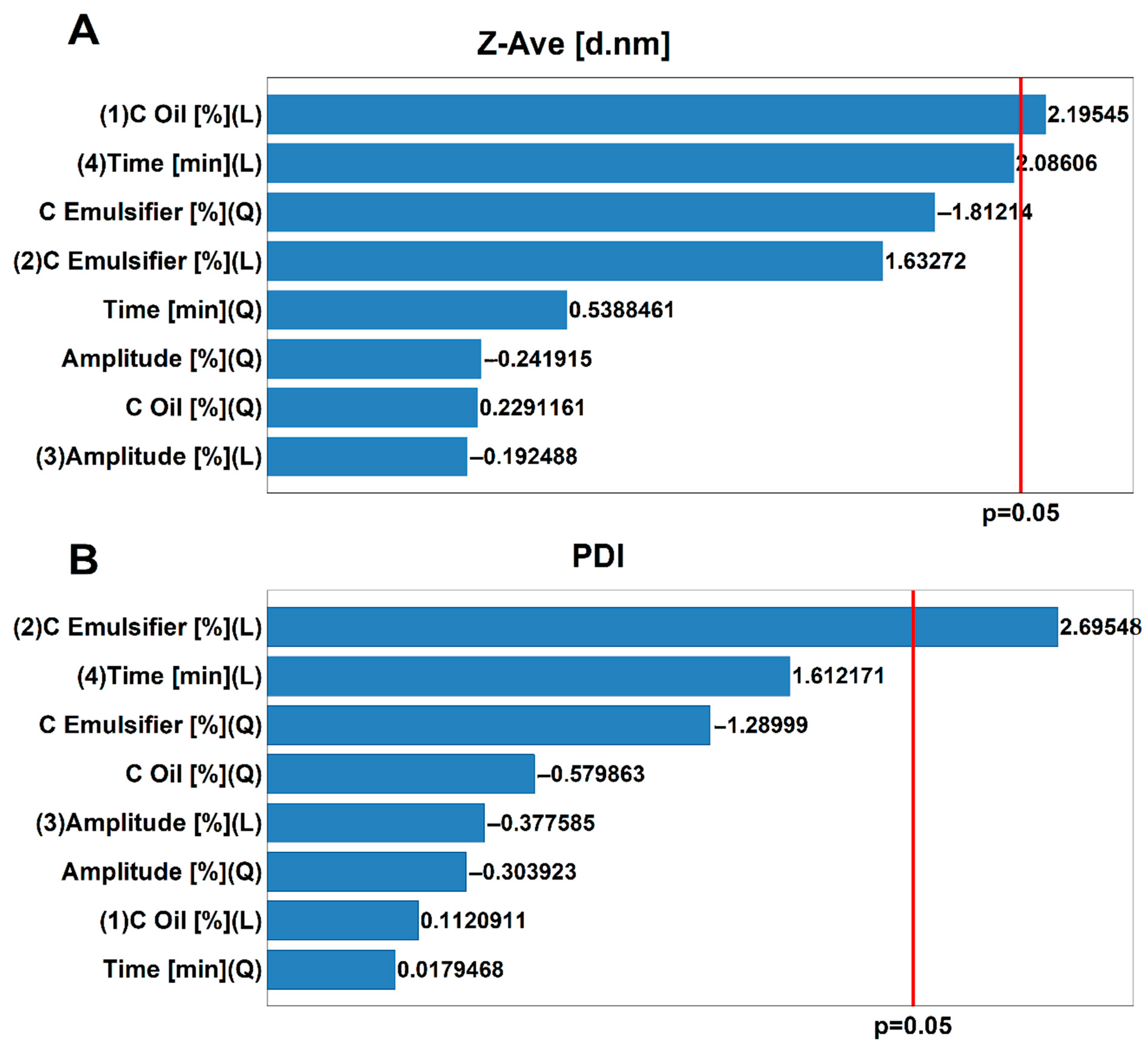
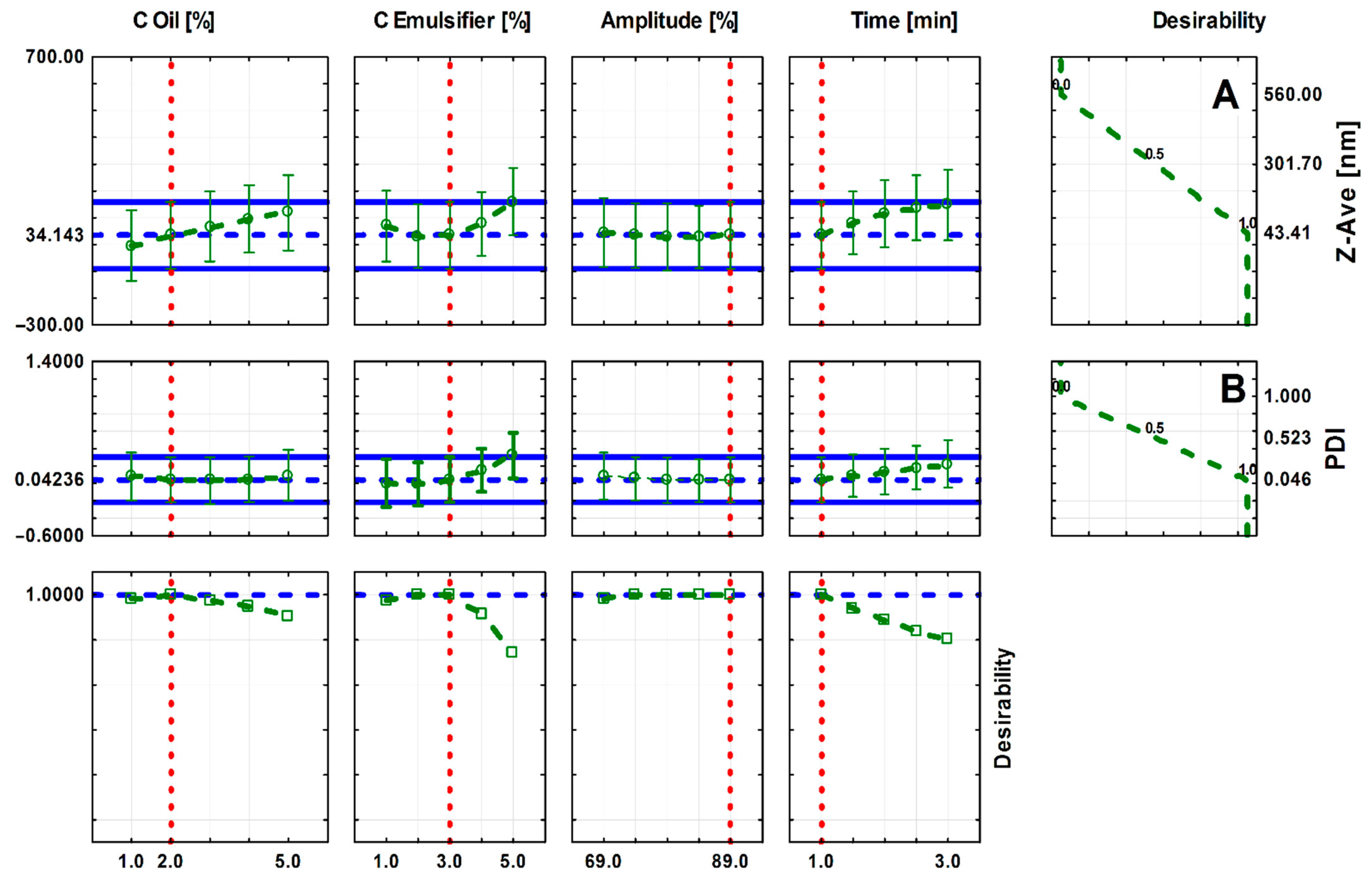

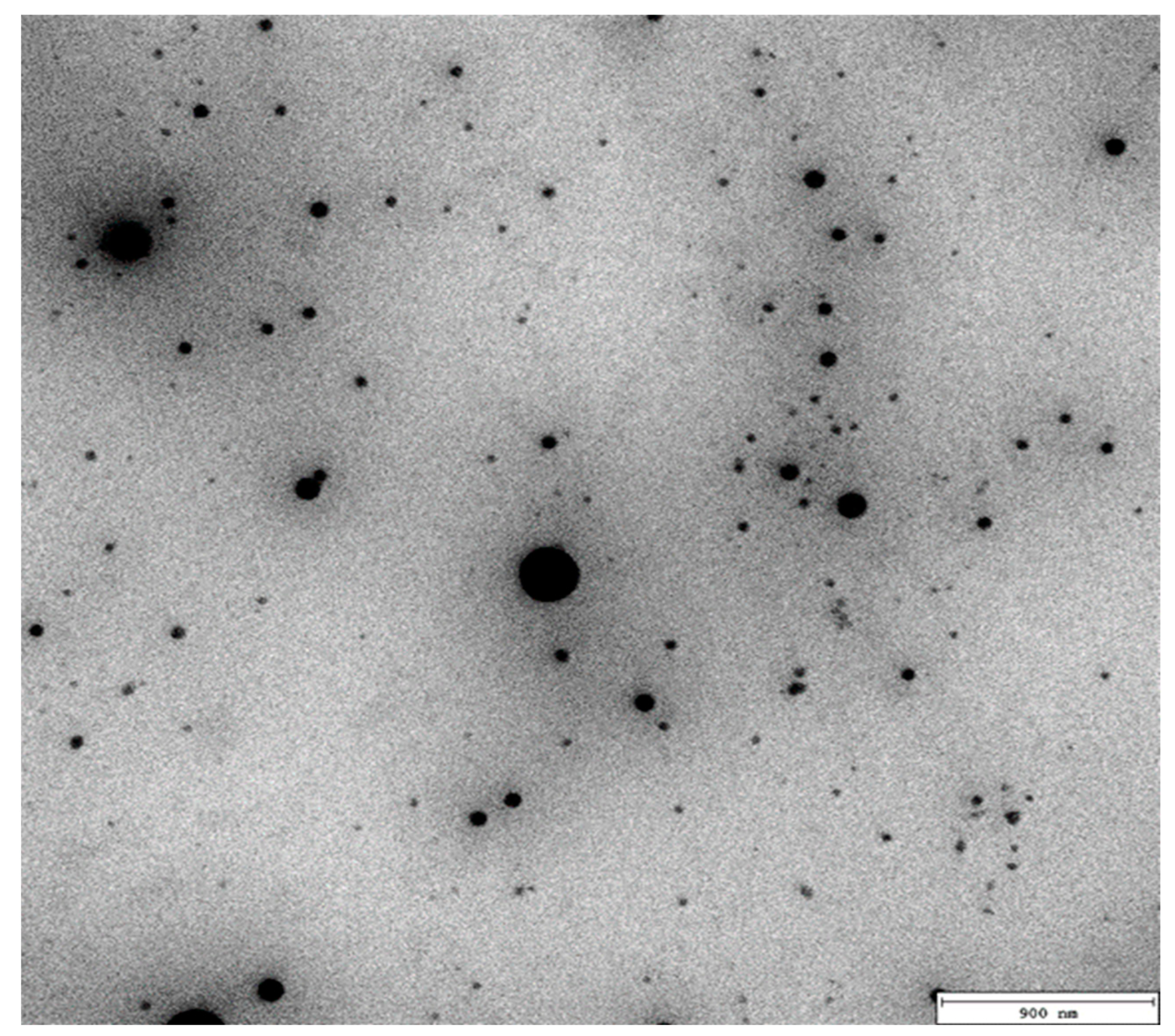


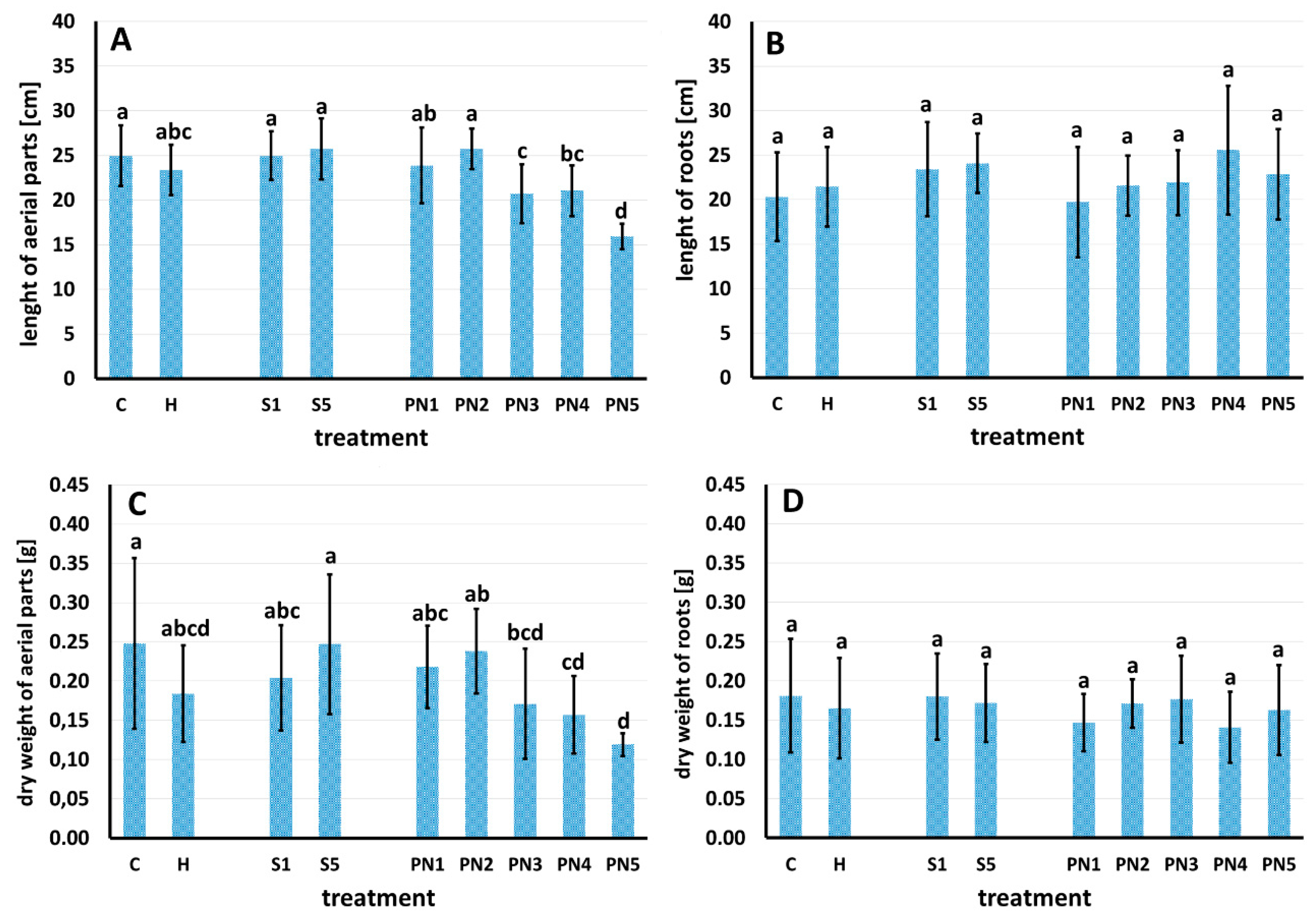
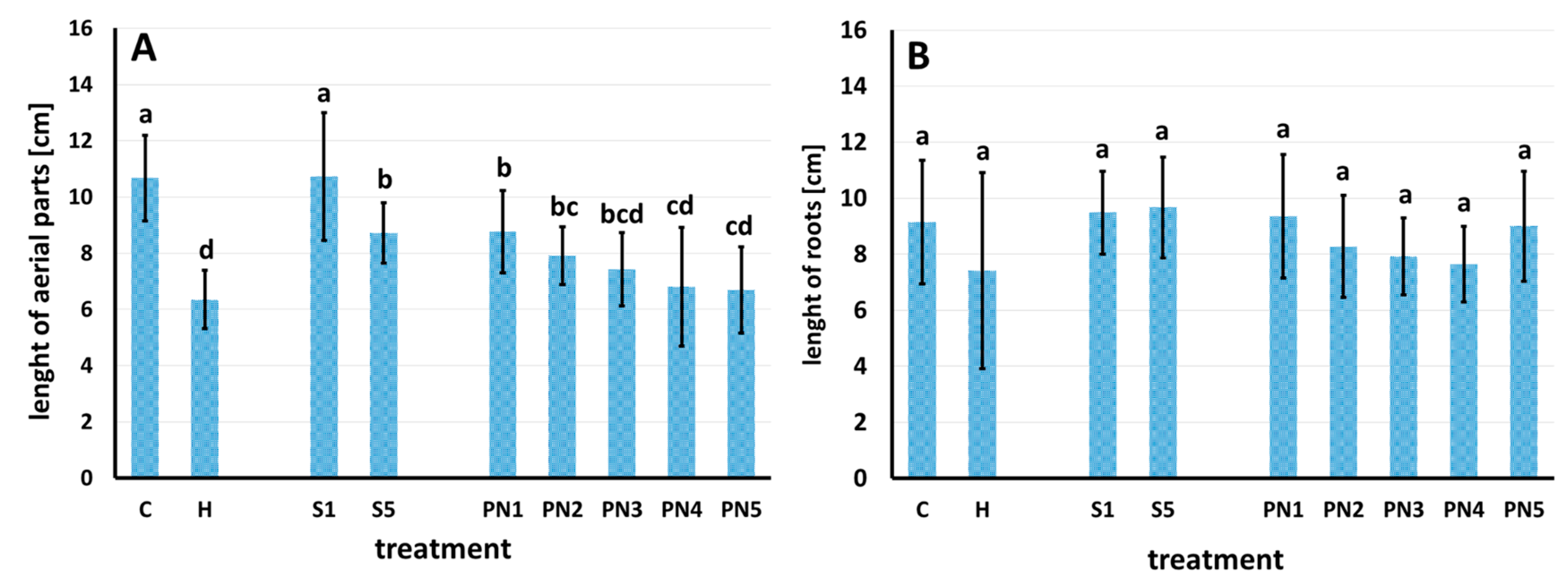

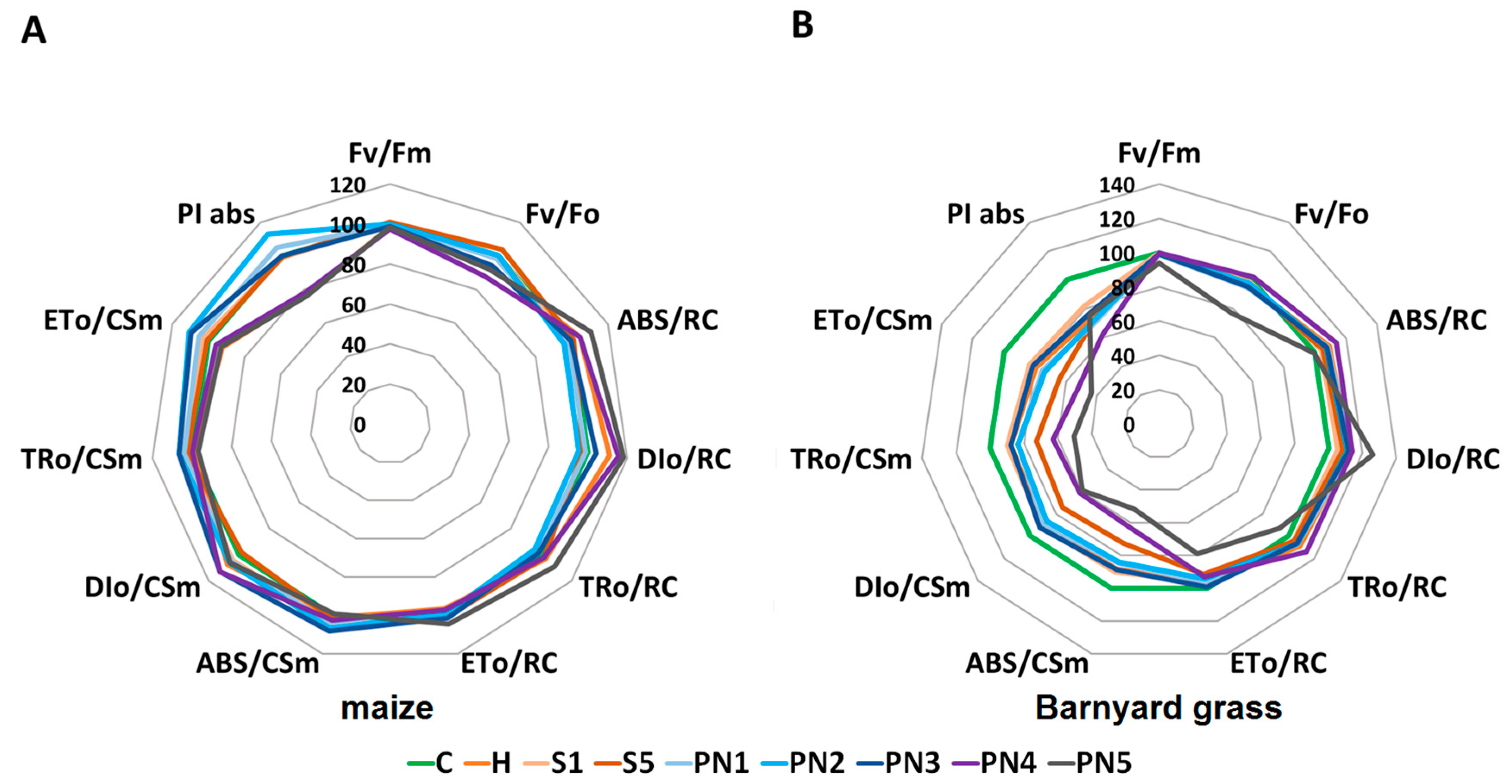
| Compounds | RI Lit 1 | RI Lab 2 | OE 3 [%] | EP 4 |
|---|---|---|---|---|
| α-Pinene | 936 | 927 | 0.2 | |
| Camphene | 950 | t 5 | ||
| Sabinene | 970 | 963 | 0.2 | |
| β-Pinene | 974 | 966 | 0.5 | |
| Octan-3-ol | 981 | 977 | t 5 | |
| p-Cymene | 1018 | 1009 | 0.6 | |
| 1,8-Cineol | 1025 | 1018 | 5.6 | |
| Limonene | 1025 | 1019 | 5.6 | 3.5–14.0 |
| γ-Terpinene | 1055 | 1052 | 0.3 | |
| Linalool | 1086 | 1086 | 0.1 | |
| Menthone | 1136 | 1138 | 27.4 | 14.0–32.0 |
| Isoborneol | 1142 | t 5 | ||
| Isomenthone | 1146 | 1145 | 4.6 | 1.5–10.0 |
| Neomenthol | 1156 | 1153 | 2.5 | |
| Menthol | 1172 | 1166 | 44.2 | 30.0–55.0 |
| Isomenthol | 1176 | 1176 | 0.2 | |
| Pulegone | 1215 | 1215 | 0.9 | 0–4.0 |
| Piperitone | 1226 | 1228 | 0.5 | |
| Neomenthyl acetate | 1263 | 1262 | 0.4 | |
| Menthyl acetate | 1280 | 1280 | 6.3 | 2.8–10.0 |
| Isomenthyl acetate | 1298 | 1294 | 0.3 | |
| β-Bourbonene | 1386 | 1386 | 0.2 | |
| β-Elemene | 1389 | 1389 | 0.1 | |
| (E)-β-Caryophyllene | 1421 | 1418 | 0.1 | |
| Spathulenol | 1572 | 1570 | 0.3 | |
| Caryophyllene oxide | 1578 | 1574 | 1.3 | |
| Globulol | 1589 | 1585 | 0.1 | |
| Total identified | 98.2 |
| Nanoemulsion (% v/v) 1 | Z-Ave (d.nm)/PDI after 24 h | Z-Ave (d.nm)/PDI t = 24 h, after 30 Days | Z-Ave (d.nm)/PDI after Stability Tests |
|---|---|---|---|
| PN-1/(1.0/1.0) | 110 ± 2.0/0.055 ± 0.015 | 111 ± 3.0/0.068 ± 0.006 | 109 ± 3.0/0.073 ± 0.005 |
| PN-2/(1.5/1.5) | 104 ± 1.0/0.048 ± 0.012 | 107 ± 3.0/0.059 ± 0.009 | 106 ± 2.0/0.039 ± 0.016 |
| PN-3/(2.0/2.0) | 99 ± 1.0/0.043 ± 0.012 | 101 ± 2.8/0.040 ± 0.010 | 103 ± 2.0/0.038 ± 0.002 |
| PN-4/(5.0/5.0) | 76 ± 0.8/0.099 ± 0.009 | 81 ± 0.6/0.046 ± 0.008 | 77 ± 2.0/0.073 ± 0.022 |
| Band | Vibrational Mode | Assignment |
|---|---|---|
| 357 | skeletal modes of the glucose pyranose ring | carbohydrates [26] |
| 440 | skeletal modes of the pyranose ring | carbohydrates [27] |
| 478 | CCO and CCC deformations; related to glycosidic ring skeletal deformations δ(C−C−C) + τ(C−O). Scissoring of C−C−C and out-of-plane bending of C−O | carbohydrates [27] |
| 577 | ν(C−O−C) Glycosidic | carbohydrates [27] |
| 713 | δ(C−C−O) related to glycosidic ring skeletal deformations | carbohydrates [27] |
| 768 | δ(C−C−O) | carbohydrates [27] |
| 865 | δ(C−C−H) + δ(C−O−C) glycosidic bond; anomeric region | carbohydrates [27] |
| 939 | δ(C−O−C) + δ(C−O−H) + ν(C−O) α-1,4 glycosidic linkages | carbohydrates [27] |
| 1051 | ν(C−O) + ν(C−C) + δ(C−O−H) | cellulose, lignin [28] |
| 1083 (1084) | ν(C−O) + ν(C−C) + δ(C−O−H) | carbohydrates [27] |
| 1126 (1125) | ν(C−O) + ν(C−C) + δ(C−O−H) | carbohydrates [27] |
| 1262 (1265) | δ(C−C−H) + δ(O−C−H) + δ(C−O−H) | carbohydrates [27] |
| 1340 | ν(C−O); δ(C−O−H) | carbohydrates [27] |
| 1380 (1379) | δ(C−O−H)—coupling of the CCH and COH deformation modes | carbohydrates [27] |
| 1460 (1459) | δ(CH2) + δ(CH3); δ(CH) + δ(CH2) + δ(C−O−H) CH, CH2 and COH deformations | aliphatic [29] carbohydrates [27] |
| 1602 | ν(C−C)ring + σ(CH) | lignin [30] |
| 1655 | ν(C=O) | amide I α-helix [31] |
| Effective Dose 1 | Maize | Barnyard Grass |
|---|---|---|
| ED10 | 2.17 ± 1.19 | -- |
| ED50 | 10.3 ± 6.07 | 1.09 ± 0.05 |
| ED90 | -- | 1.67 ± 0.19 |
Publisher’s Note: MDPI stays neutral with regard to jurisdictional claims in published maps and institutional affiliations. |
© 2022 by the authors. Licensee MDPI, Basel, Switzerland. This article is an open access article distributed under the terms and conditions of the Creative Commons Attribution (CC BY) license (https://creativecommons.org/licenses/by/4.0/).
Share and Cite
Rys, M.; Miastkowska, M.; Sikora, E.; Łętocha, A.; Krajewska, A.; Synowiec, A. Bio-Herbicidal Potential of Nanoemulsions with Peppermint Oil on Barnyard Grass and Maize. Molecules 2022, 27, 3480. https://doi.org/10.3390/molecules27113480
Rys M, Miastkowska M, Sikora E, Łętocha A, Krajewska A, Synowiec A. Bio-Herbicidal Potential of Nanoemulsions with Peppermint Oil on Barnyard Grass and Maize. Molecules. 2022; 27(11):3480. https://doi.org/10.3390/molecules27113480
Chicago/Turabian StyleRys, Magdalena, Małgorzata Miastkowska, Elżbieta Sikora, Anna Łętocha, Agnieszka Krajewska, and Agnieszka Synowiec. 2022. "Bio-Herbicidal Potential of Nanoemulsions with Peppermint Oil on Barnyard Grass and Maize" Molecules 27, no. 11: 3480. https://doi.org/10.3390/molecules27113480
APA StyleRys, M., Miastkowska, M., Sikora, E., Łętocha, A., Krajewska, A., & Synowiec, A. (2022). Bio-Herbicidal Potential of Nanoemulsions with Peppermint Oil on Barnyard Grass and Maize. Molecules, 27(11), 3480. https://doi.org/10.3390/molecules27113480









